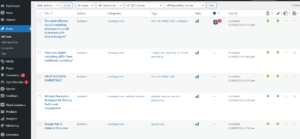In the ever-evolving landscape of digital marketing, on-page SEO remains a critical component of any successful online strategy. On-page SEO refers to the practice of optimizing individual web pages to rank higher in search engine results and How to get more organic traffic in websites attract more organic traffic. Unlike off-page SEO, which focuses on external factors like backlinks, on-page SEO involves optimizing the content and HTML source code of a page. When done correctly, it can significantly improve your website’s visibility, user experience, and ultimately, your bottom line.
This guide will walk you through the essential elements of on-page SEO and provide actionable tips to perfect each aspect, ensuring your website is well-positioned to attract maximum organic traffic.
1. Title Tags: Crafting Click-Worthy Headlines(To get more organic traffic)
The title tag is one of the most critical on-page SEO elements. It appears as the clickable headline in search engine results pages (SERPs) and plays a significant role in both ranking and click-through rate (CTR).
To perfect your title tags:
- Incorporate Your Primary Keyword: Ensure your main keyword is included in the title tag, ideally towards the beginning.
- Keep It Under 60 Characters: Google typically displays the first 50-60 characters of a title. Keeping it concise ensures the entire title is visible.
- Make It Compelling: Beyond SEO, your title should entice users to click. Use power words, numbers, or questions to make your title stand out.
2. Meta Descriptions: The SERP Snippet That Sells
While meta descriptions don’t directly impact rankings, they influence CTR, which can affect your rankings indirectly. A well-crafted meta description provides a summary of the page’s content and encourages users to click on your link.
To optimize your meta descriptions:
- Include Your Primary Keyword: While not a ranking factor, including your keyword can make the description more relevant to the search query.
- Keep It Between 150-160 Characters: This ensures the entire description is visible in SERPs.
- Use a Call to Action (CTA): Phrases like “Learn more,” “Discover,” or “Get started” can prompt users to click.
3. Header Tags: Structuring Your Content for Readability and SEO
Header tags (H1, H2, H3, etc.) help structure your content, making it easier for search engines and users to understand. The H1 tag is typically the title of the page, while H2s, H3s, and beyond are used for subheadings.
To optimize your header tags:
- Use One H1 Tag Per Page: The H1 tag should reflect the main topic of the page and include your primary keyword.
- Incorporate Keywords in Subheadings: Use H2s and H3s to break up your content and include secondary keywords where relevant.
- Maintain a Logical Hierarchy: Ensure your header tags follow a logical order, with H2s under H1s, H3s under H2s, and so on.
4. URL Structure: Creating Clean, Keyword-Rich URLs
Your URL structure is another crucial on-page SEO element. A well-optimized URL can improve user experience and signal to search engines what the page is about.
To create optimized URLs:
- Include Your Primary Keyword: The URL should contain the primary keyword for the page.
- Keep It Short and Descriptive: Aim for a URL that is concise and directly related to the page’s content.
- Use Hyphens to Separate Words: This improves readability for both users and search engines.
5. Content Optimization: Delivering Value and Relevance
How to get more organic traffic in websites ,content is the backbone of on-page SEO. Search engines prioritize content that is relevant, valuable, and well-written.
To optimize your content:
- Focus on User Intent: Understand what users are looking for when they search your primary keyword and create content that meets their needs.
- Incorporate Keywords Naturally: Use your primary keyword and related keywords throughout the content, but avoid keyword stuffing.
- Provide Comprehensive Coverage: Aim to cover the topic in-depth, addressing all possible questions or subtopics that users might be interested in.
- Use Internal Linking: Link to other relevant pages on your site to keep users engaged and help search engines crawl your site more effectively.
6. Image Optimization: Enhancing Visual Content for SEO
Images play a crucial role in enhancing the user experience, but they also offer an opportunity for SEO optimization.
To optimize images for SEO:
- Use Descriptive File Names: Rename image files to include relevant keywords before uploading them.
- Optimize Alt Text: The alt text should describe the image accurately and include your primary keyword if relevant.
- Compress Images for Faster Load Times: Large image files can slow down your page, negatively impacting both user experience and rankings. Use tools like TinyPNG or ImageOptim to compress images without sacrificing quality.
7. Internal Linking: Building a Cohesive Site Structure
Internal linking is the practice of linking one page on your website to another. This helps distribute page authority throughout your site and improves navigation.
To optimize internal linking:
- Use Descriptive Anchor Text: The clickable text of the link should give users and search engines a clear idea of the linked page’s content.
- Link to High-Value Pages: Prioritize linking to pages that are important for your site’s overall goals, such as conversion pages or high-traffic content.
- Avoid Over-Linking: Too many internal links can be overwhelming. Aim for a balance that guides users naturally through your content.
8. Mobile Optimization: Ensuring a Seamless Experience on All Devices
With mobile traffic now exceeding desktop traffic, mobile optimization is no longer optional. Google’s mobile-first indexing means that the mobile version of your site is considered the primary version.
To ensure your site is mobile-friendly:
- Use Responsive Design: Ensure your website automatically adjusts to fit any screen size.
- Improve Page Load Speed to get more organic traffic in websites: Mobile users expect fast-loading pages. Optimize images, minimize redirects, and leverage browser caching.
- Simplify Navigation: Use a clean, easy-to-use navigation menu that works well on smaller screens.
9. Page Load Speed: Enhancing User Experience and SEO
Page load speed is a critical ranking factor and directly affects user experience. How to get more organic traffic in websites,slow-loading pages can lead to higher bounce rates and lower rankings.
To improve page load speed:
- Enable Compression: Use Gzip or Brotli to reduce the size of CSS, HTML, and JavaScript files.
- Minify Code: Remove unnecessary characters, spaces, and comments from your code to reduce file sizes.
- Leverage Browser Caching: Store frequently used resources in the user’s browser to reduce load times on repeat visits.
- Optimize Server Response Time: Choose a reliable hosting provider and consider using a Content Delivery Network (CDN) to distribute your content more efficiently.
10. User Experience (UX): The Ultimate Goal of On-Page SEO
At its core, on-page SEO is about creating a positive user experience. A site that is easy to navigate, quick to load, and full of valuable content will naturally rank higher in search results.
To optimize for user experience:
- Improve Site Navigation: Ensure users can easily find what they’re looking for with a well-organized menu and internal linking structure.
- Use Engaging and Relevant Content: Keep users engaged with high-quality content that is both informative and visually appealing.
- Focus on Accessibility: Make your site accessible to all users, including those with disabilities, by following accessibility best practices.
Conclusion
How to get more organic traffic in websites,perfecting your on-page SEO is a multifaceted process that requires attention to detail and a focus on both technical and content-related aspects. By optimizing each element of your web pages, from title tags and meta descriptions to content quality and user experience, you can significantly improve your site’s visibility in search engines and attract more organic traffic.
Remember, on-page SEO is not a one-time task but an ongoing process. Regularly updating your content, monitoring performance, and staying current with the latest SEO best practices will ensure your site continues to rank well and attract visitors over the long term.
